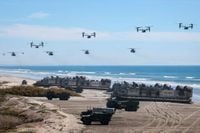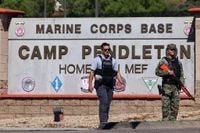On a sunny Saturday afternoon, the usually bustling Interstate 5 near San Diego, California, came to an abrupt halt as a major military celebration took an unexpected turn. What was intended as a dazzling display of American military prowess for the U.S. Marine Corps’ 250th anniversary at Camp Pendleton instead became the center of a safety controversy, after a live artillery round fired over the freeway prematurely detonated, showering metal shrapnel onto a California Highway Patrol (CHP) vehicle assigned to Vice President J.D. Vance’s security detail.
The incident, which occurred on October 18, 2025, immediately drew national attention. According to CNN, electronic signs along Interstate 8 near the I-5 junction warned motorists of “Live Weapons Over Freeway.” The warning wasn’t just for show: as part of the celebration, Marines fired a 155 mm shell from an M777 howitzer over Interstate 5—one of the busiest roads in the United States—toward the base’s Whiskey Impact Area, a zone long used for such exercises. But this time, things didn’t go as planned.
As The Los Angeles Times reported, the artillery round detonated overhead, scattering shrapnel across the area near the Las Pulgas Road onramp to southbound I-5 in northern San Diego County. The CHP’s internal report described how shrapnel, measuring about two inches by two and a half inches, struck the hood of an unoccupied patrol vehicle, leaving a “small dent/scratch.” An officer nearby heard what sounded like “pebbles falling” on his motorcycle and the ground around him. A metal fragment, about an inch long and half an inch wide, was later found near the motorcycle. Thankfully, no injuries were reported, a fact confirmed by Tony Coronado, head of the CHP’s Border Division.
“This was an unusual and concerning situation,” Coronado said in a statement. “It is highly uncommon for any live-fire or explosive training activity to occur over an active freeway. As a Marine myself, I have tremendous respect for our military partners, but my foremost responsibility is ensuring the safety of the people of California and the officers who protect them.”
The event, attended by an estimated 15,000 guests—including active duty sailors, Marines, veterans, Defense Secretary Pete Hegseth, and Vice President Vance—was meant to be a highlight of the Marine Corps’ Amphibious Capabilities Demonstration. Attendees watched a live video feed of the exercise, which featured Marines moving from Navy ships offshore onto Pendleton’s Red Beach, with artillery rounds arcing over the freeway into the impact zone.
But after the shrapnel incident, the Marine Corps immediately canceled any further live-fire over the freeway. According to the CHP, Marines had planned to fire approximately 60 rounds, but the exercise was terminated after the first shell failed to clear the roadway and detonated mid-flight. The area was then swept for further evaluation, and an investigation into the incident was launched, as confirmed by Capt. Gregory Dreibelbis of the I Marine Expeditionary Force.
“We are aware of the report of a possible airborne detonation of a 155mm artillery round outside the designated impact area during the U.S. Marine Corps Amphibious Capabilities Demonstration at Camp Pendleton,” Dreibelbis said in an email. “The demonstration went through a rigorous safety evaluation and deliberate layers of redundancy, to ensure the safety of fellow citizens.” He added that firing would be suspended until the root cause of the apparent misfire was determined. Dreibelbis expressed continued confidence in the M777 artillery system, stating, “Indirect weapons systems, such as the M777, are designed to fire over the heads of friendly forces to achieve effects on our adversary. We trust this system with our lives.”
The fallout from the incident quickly turned political. California Governor Gavin Newsom, who had already been at odds with the White House over the safety of the demonstration, was quick to criticize the decision to conduct live-fire exercises over a major freeway. “We love our Marines and owe a debt of gratitude to Camp Pendleton,” Newsom said in a statement posted on X, “but next time, the Vice President and the White House shouldn’t be so reckless with people’s lives for their vanity projects.” Newsom’s office called the event “reckless” and demanded an apology from the Trump administration, noting that the White House’s rapid response team had accused Newsom of closing Interstate 5 when “nobody at the White House or the Marines” asked him to do so.
The lead-up to the event was marked by tense back-and-forth between state and federal officials. While Pendleton officials initially suggested that closing the freeway was unnecessary because live fire would be confined to approved ranges, the state ultimately decided to close a 17-mile stretch of I-5 from just south of San Clemente to just north of Oceanside. The closure, which lasted from 11 a.m. to 3 p.m., caused massive traffic jams across San Diego and Orange counties, forcing motorists to take lengthy detours and adding hours to their travel times. The closure hit a vital traffic artery connecting Los Angeles and San Diego, and even though it was brief, its impact was felt by thousands.
According to CNN, the Marine Corps has not responded to questions about who authorized the artillery fire over the interstate, when such an exercise was last conducted, or whether there are broader concerns about the ammunition used. The incident has also drawn attention to the broader context of U.S. military ammunition production: since 2022, production of 155 mm shells has more than tripled to about 40,000 rounds per month, driven in part by Ukraine’s ongoing war with Russia. The United States has shipped over 3 million 155-mm rounds to Ukraine since the conflict began, and the M777 howitzer—the same model used in Saturday’s demonstration—has been a key component of that support.
For many, the incident at Camp Pendleton raises questions about the balance between military tradition and public safety. Military live-fire demonstrations are not uncommon in the United States, but as one American official told CNN, it had been more than seventy years since the Marine Corps last fired artillery over a section of Interstate 5 in California. “Shooting from the beach, shooting over I‑5 – theoretically this should not have posed any problems,” the official said. “The shells were well above I‑5 at the moment of passing, and that is why the Corps evidently said that closing the road was unnecessary – because, in theory, they were high enough not to interfere with anyone below.”
Yet, as the shrapnel incident demonstrated, even the most carefully planned exercises can go awry. The CHP’s Tony Coronado summed up the sentiment: “Of course, this should not have happened.”
As the Marine Corps continues its investigation, officials at every level are left to grapple with the lessons of a day that was supposed to celebrate military heritage but instead sparked a debate about risk, responsibility, and the cost of spectacle on public safety.





